War of Independence 1809-1825
The Bolivian war of independence began in 1809 with the establishment of government juntas in Sucre and La Paz, after the Chuquisaca Revolution and La Paz revolution. These Juntas were defeated shortly after, and the cities fell again under Spanish control. The May Revolution of 1810 ousted the viceroy in Buenos Aires, which established its own junta. Buenos Aires sent three military campaigns to the Charcas, headed by Juan José Castelli, Manuel Belgrano and José Rondeau, but the royalists ultimately prevailed over each one. However, the conflict grew into a guerrilla war, the War of the Republiquetas (indigenous people), preventing the royalists from strengthening their presence. After Simon Bolívar and Antonio Jose de Sucre defeated the royalists in northern South America, Sucre led a campaign which defeated the royalists in Charcas when the last royalist general, Pedro Antonio Olaneta, suffered death and defeat at the hands of his own forces at the Battle of Tumusla. Bolivian independence was proclaimed on August 6 of 1825.


Medal for Ayacucho 1824 Gold and Silver
Battle of Ayacucho
This was a decisive military encounter during the Peruvian War of Independence. It was the battle that secured the independence of Peru and ensured independence for the rest of South America. In Peru it is considered the end of the Spanish American wars of independence, although the campaign of the victor Antonio José de Sucre, continued through 1825 in Upper Peru including the siege of the fortresses at Chiloe and Callao, which finally ended in 1826. The Medal for Ayacucho 1824 was awarded to patriot troops under Simon Bolivar and General Sucre for their victory over the Spanish forces led by the Viceroy La Serna, at Ayacucho on December 9, 1824. Of the battle, Simon Bolivar stated: "The Battle of Ayacucho is the summit of American glory, and the work of General Sucre. The planning of it was perfect, and the execution divine. Coming generations will commemorate the victory of Ayacucho to bless it and contemplate it sitting on the throne of freedom, commanding to Americans the exercise of their rights and the sacred laws of nature."
Medal for Ayacucho 1824
This award was authorized by a decree of the independent government issued from the capital at Chuquisaca on August 11, 1825. It is an oval medal, 42mm X 36mm, awarded in gold or silver. The obverse reflects the mountain of Potosi, with a trophy of arms and flags in pyramidal form, with the figure of Bolivar holding a staff bearing a liberty cap. The exergue is inscribed, POTOSI, and the upper field depicts a radiant sun. The reverse is inscribed, within laurel branches, LA REPUBLICA BOLIVAR AGRADECIDA AL HEROE CUYO NOMBRE LLEVA.
Medal for Cobija 1825
This is an oval shaped silver medal, 34mm X 30mm, awarded to the Bolivian troops taking part in the War for Independence. The obverse bears the early form of the arms of Bolivia with BOLIVIA A S US DEFENSORES above, and six stars below. The reverse edge is beaded and in the lower field is an oval of rope, within which is a sailing ship; above this is EN COBIJA. A reverse variant depicts the seated figure of Justice, holding a sword in the right hand and scales in her left hand. Cobija, or Puerto la Mar, a seaport town and formerly Bolivia's Pacific port, is now part of the Chilean province of Antofagasta.

Medal for Cobija 1825
On January 22, 1826, Callao, a seaside city on the Pacific coast, was besieged by land and by sea by nationalist forces backed by Simon Bolívar, Spanish General Jose Ramon Rodil surrendered Callao to General Bartolomé Salom Borges. The Spaniards, who survived were allowed to return to Spain.
Cross for Callao 1826
Awarded by President Antonio Jose Sucre (1793–1830), to the Bolivian troops aiding in the defense of Callao, Peru against the Spanish. The decoration is a green-enameled cross of six arms, bearing on the obverse medallion the head of the president encircled by a band inscribed BOL A LOS VENC DEL CALLAO. The reverse depicts the arms of Bolivia. The ribbon is red, blue and white.
Medal for Callao 1826
This is an oval shaped silver medal, 32mm X 30mm, with beaded border, bearing on the obverse a soldier scaling a tower on a ladder and the curved inscription, RENDIDO EL CALLAO AL VALOR SIN EJEMPLO. The reverse, within palm and laurel branches, is a tower from which a flag is flying; above is TOMA DEL CALLAO, and below ANO DE 1826.
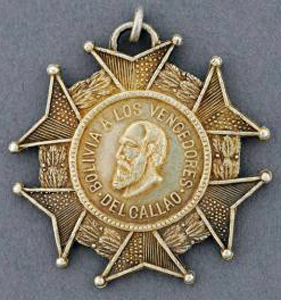
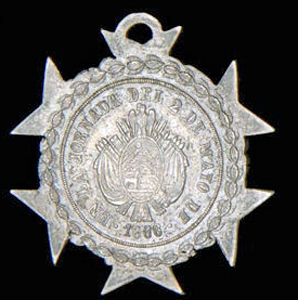
Cross for Callao 1826 – Obverse & Reverse
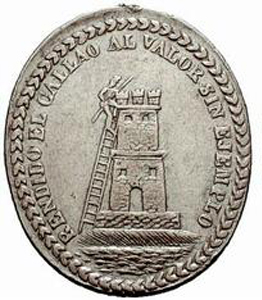
Medal for Callao 1826
Cross of Bolivar
Although no record of this award being instituted has been discovered, the Cross appeared in a 1926 auction. It was a 33mm, silver pattern piece in the form of a five-armed double pointed cross with rays between the points and a bust of Bolivar facing right on the obverse and the inscription, LIBERTADOR SIMON BOLIVAR. The reverse reflects the arms of Bolivia and the inscription, REPUBLICA BOLIVIANA.
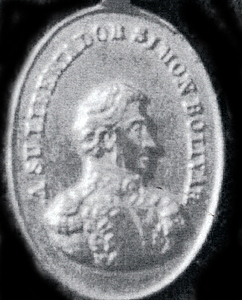
Medal of Bolivar
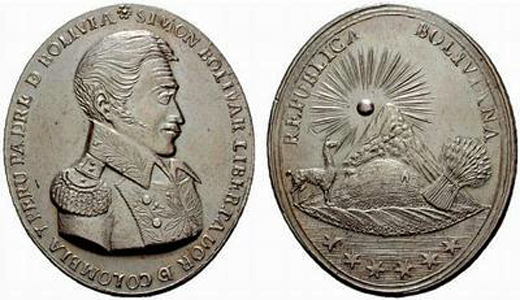
Medal of Bolivar Second Variant
Medal of Bolivar
The obverse of 33mm X 28mm oval, silver medal depicts the bust of Bolivar in uniform facing his left and the inscription, A SU LIBERTADOR SIMON BOLIVAR above. The reverse reflects the arms of Bolivia with six small stars below and the inscription, REPUBLICA BOLIVIANA. A variant with the obverse inscription, SIMON BOLIVAR LIBERTADOR DE COLOMBIA Y PERU PADRE DE BOLIVIA. A third 35mm X 30mm variant with the arms of Bolivia and six small stars below with the inscription, EL SENADO RECONOCE LOS GRANDES SERVICIOS DE SU CUIDADANO.
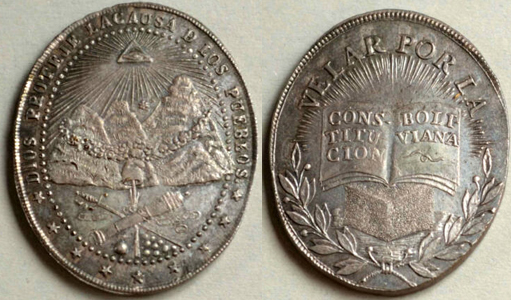
Medal of Independence 1825
Medal of Independence 1825
The obverse features a radiant all-seeing eye above the three wreathed mountains and liberty cap above crossed sword and cannon with nine small stars at the bottom. The inscription around the upper portion reads, DIOS PROTEJE LA CAUSE DE LOS PUEBLOS. The reverse features an open book on a pedestal and the curved inscription curved at the top reads, VELAR POR LA and in the open book, CONSTITUCION on three lines on the left and BOLIVIANA on two lines to the right. There is a laurel wreath framing the base of the reverse.
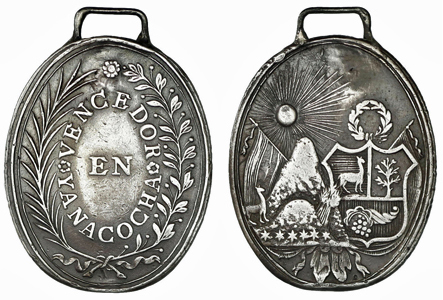
Medal for Yanacocha Variant 1835
Medal for Yanacocha 1835
During 1835, two political factions were struggling for control of Peru and Andres de Santa Cruz and the Bolivian army went to the aid of the Peruvians, defeating Augustin Gamarra at Yanacocha, August 13, 1835. The obverse of the 35mm silver medal bears a sunburst with the early arms of Bolivia in the center, with the inscription, REPUBLICA BOLIVIANA above and six stars below. The reverse center within a circle reads, AUClLIANDO AL PERU with the field inscribed, EN 13 DE AGOSTO D 1835. An oval, 32mm X 27mm silver variation of this medal is inscribed on the obverse VENCEDOR EN YANACOCHA within a palm and laurel wreath. The reverse depicts the combined arms of Bolivia and Peru.
Victory at Yanacocha 1835
Three variants were discovered. Variant 1 is a seven-pointed star inside of a seven-pointed star with finial balls. The center depicts a hand holding a liberty cap on a staff.
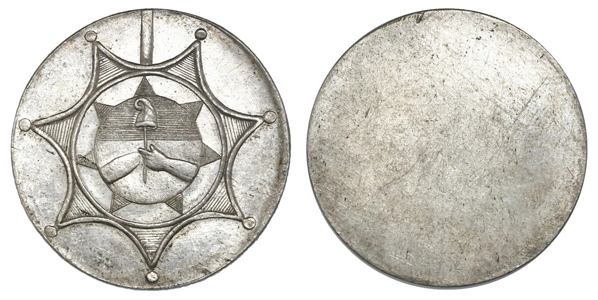
Victory at Yanacocha Variant 1
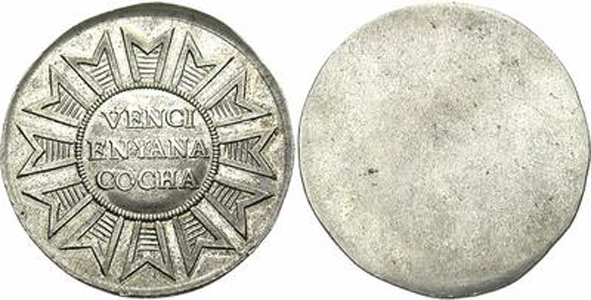
Victory at Yanacocha Variant 2
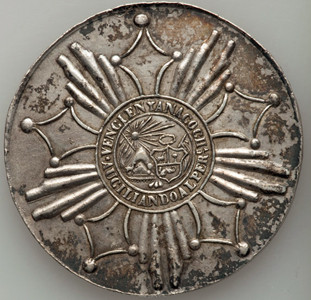
Victory at Yanacocha Variant 3
Variant 2 is a 12 double-pointed 33mm star with the three-line central inscription, VENCI EN YANACOCHA. The reverse is blank.
Variant 3 is in the form of a five-armed cross is inscribed, VENCI EN YANACOCHA AUCILIANDO AL PERU around the arms of Peru and Bolivia.
The Bolivian war of independence began in 1809 with the establishment of government juntas in Sucre and La Paz, after the Chuquisaca Revolution and La Paz revolution. These Juntas were defeated shortly after, and the cities fell again under Spanish control. The May Revolution of 1810 ousted the viceroy in Buenos Aires, which established its own junta. Buenos Aires sent three military campaigns to the Charcas, headed by Juan José Castelli, Manuel Belgrano and José Rondeau, but the royalists ultimately prevailed over each one. However, the conflict grew into a guerrilla war, the War of the Republiquetas (indigenous people), preventing the royalists from strengthening their presence. After Simon Bolívar and Antonio Jose de Sucre defeated the royalists in northern South America, Sucre led a campaign which defeated the royalists in Charcas when the last royalist general, Pedro Antonio Olaneta, suffered death and defeat at the hands of his own forces at the Battle of Tumusla. Bolivian independence was proclaimed on August 6 of 1825.


Medal for Ayacucho 1824 Gold and Silver
Battle of Ayacucho
This was a decisive military encounter during the Peruvian War of Independence. It was the battle that secured the independence of Peru and ensured independence for the rest of South America. In Peru it is considered the end of the Spanish American wars of independence, although the campaign of the victor Antonio José de Sucre, continued through 1825 in Upper Peru including the siege of the fortresses at Chiloe and Callao, which finally ended in 1826. The Medal for Ayacucho 1824 was awarded to patriot troops under Simon Bolivar and General Sucre for their victory over the Spanish forces led by the Viceroy La Serna, at Ayacucho on December 9, 1824. Of the battle, Simon Bolivar stated: "The Battle of Ayacucho is the summit of American glory, and the work of General Sucre. The planning of it was perfect, and the execution divine. Coming generations will commemorate the victory of Ayacucho to bless it and contemplate it sitting on the throne of freedom, commanding to Americans the exercise of their rights and the sacred laws of nature."
Medal for Ayacucho 1824
This award was authorized by a decree of the independent government issued from the capital at Chuquisaca on August 11, 1825. It is an oval medal, 42mm X 36mm, awarded in gold or silver. The obverse reflects the mountain of Potosi, with a trophy of arms and flags in pyramidal form, with the figure of Bolivar holding a staff bearing a liberty cap. The exergue is inscribed, POTOSI, and the upper field depicts a radiant sun. The reverse is inscribed, within laurel branches, LA REPUBLICA BOLIVAR AGRADECIDA AL HEROE CUYO NOMBRE LLEVA.
Medal for Cobija 1825
This is an oval shaped silver medal, 34mm X 30mm, awarded to the Bolivian troops taking part in the War for Independence. The obverse bears the early form of the arms of Bolivia with BOLIVIA A S US DEFENSORES above, and six stars below. The reverse edge is beaded and in the lower field is an oval of rope, within which is a sailing ship; above this is EN COBIJA. A reverse variant depicts the seated figure of Justice, holding a sword in the right hand and scales in her left hand. Cobija, or Puerto la Mar, a seaport town and formerly Bolivia's Pacific port, is now part of the Chilean province of Antofagasta.

Medal for Cobija 1825
On January 22, 1826, Callao, a seaside city on the Pacific coast, was besieged by land and by sea by nationalist forces backed by Simon Bolívar, Spanish General Jose Ramon Rodil surrendered Callao to General Bartolomé Salom Borges. The Spaniards, who survived were allowed to return to Spain.
Cross for Callao 1826
Awarded by President Antonio Jose Sucre (1793–1830), to the Bolivian troops aiding in the defense of Callao, Peru against the Spanish. The decoration is a green-enameled cross of six arms, bearing on the obverse medallion the head of the president encircled by a band inscribed BOL A LOS VENC DEL CALLAO. The reverse depicts the arms of Bolivia. The ribbon is red, blue and white.
Medal for Callao 1826
This is an oval shaped silver medal, 32mm X 30mm, with beaded border, bearing on the obverse a soldier scaling a tower on a ladder and the curved inscription, RENDIDO EL CALLAO AL VALOR SIN EJEMPLO. The reverse, within palm and laurel branches, is a tower from which a flag is flying; above is TOMA DEL CALLAO, and below ANO DE 1826.


Cross for Callao 1826 – Obverse & Reverse

Medal for Callao 1826
Cross of Bolivar
Although no record of this award being instituted has been discovered, the Cross appeared in a 1926 auction. It was a 33mm, silver pattern piece in the form of a five-armed double pointed cross with rays between the points and a bust of Bolivar facing right on the obverse and the inscription, LIBERTADOR SIMON BOLIVAR. The reverse reflects the arms of Bolivia and the inscription, REPUBLICA BOLIVIANA.

Medal of Bolivar

Medal of Bolivar Second Variant
Medal of Bolivar
The obverse of 33mm X 28mm oval, silver medal depicts the bust of Bolivar in uniform facing his left and the inscription, A SU LIBERTADOR SIMON BOLIVAR above. The reverse reflects the arms of Bolivia with six small stars below and the inscription, REPUBLICA BOLIVIANA. A variant with the obverse inscription, SIMON BOLIVAR LIBERTADOR DE COLOMBIA Y PERU PADRE DE BOLIVIA. A third 35mm X 30mm variant with the arms of Bolivia and six small stars below with the inscription, EL SENADO RECONOCE LOS GRANDES SERVICIOS DE SU CUIDADANO.

Medal of Independence 1825
Medal of Independence 1825
The obverse features a radiant all-seeing eye above the three wreathed mountains and liberty cap above crossed sword and cannon with nine small stars at the bottom. The inscription around the upper portion reads, DIOS PROTEJE LA CAUSE DE LOS PUEBLOS. The reverse features an open book on a pedestal and the curved inscription curved at the top reads, VELAR POR LA and in the open book, CONSTITUCION on three lines on the left and BOLIVIANA on two lines to the right. There is a laurel wreath framing the base of the reverse.

Medal for Yanacocha Variant 1835
Medal for Yanacocha 1835
During 1835, two political factions were struggling for control of Peru and Andres de Santa Cruz and the Bolivian army went to the aid of the Peruvians, defeating Augustin Gamarra at Yanacocha, August 13, 1835. The obverse of the 35mm silver medal bears a sunburst with the early arms of Bolivia in the center, with the inscription, REPUBLICA BOLIVIANA above and six stars below. The reverse center within a circle reads, AUClLIANDO AL PERU with the field inscribed, EN 13 DE AGOSTO D 1835. An oval, 32mm X 27mm silver variation of this medal is inscribed on the obverse VENCEDOR EN YANACOCHA within a palm and laurel wreath. The reverse depicts the combined arms of Bolivia and Peru.
Victory at Yanacocha 1835
Three variants were discovered. Variant 1 is a seven-pointed star inside of a seven-pointed star with finial balls. The center depicts a hand holding a liberty cap on a staff.

Victory at Yanacocha Variant 1

Victory at Yanacocha Variant 2

Victory at Yanacocha Variant 3
Variant 2 is a 12 double-pointed 33mm star with the three-line central inscription, VENCI EN YANACOCHA. The reverse is blank.
Variant 3 is in the form of a five-armed cross is inscribed, VENCI EN YANACOCHA AUCILIANDO AL PERU around the arms of Peru and Bolivia.
Website Maintained by Vaudezilla